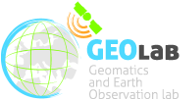Earth Observation
Earth Observation is a nexus in modern geospatial science and is one of the core research domains of the team. Many members of the team have been involved for years in projects and researches exploiting satellite data and applications connected to land use mapping, air and water quality monitoring, natural hazards and urban environment analysis.
Artificial Intelligence
Among the most emerging research interests of the team is Artificial Intelligence (AI), applied especially to spatial data modelling (GeoAI). This topic is rapidly growing in geospatial sciences and the most relevant applications include Earth Observation, health data analysis, disaster risk assessment and environmental quality monitoring.
Web Mapping
One of the core research domains of the team is Web Mapping, a general term which points to the collection of services and data supporting the use of geographic information over the Internet. A term used somehow as a synonym is GeoWeb, which has been recently renamed GeoWeb 2.0 after the rise of the new Web applications gone under the definition of Web 2.0.
VGI and Citizen Science
The team has a multi-year research experience in Volunteered Geographic Information (VGI) and Citizen Science, covering aspects such as data quality, analysis of user participation and contribution patterns, data collection in VGI projects. Special attention is given to the OpenStreetMap project, which represents the most popular VGI project.
Spatial Statistics
The research team is active in the domain of spatial statistics, in particular in the development of tools and techniques aiming to provide new solutions for the analysis and mapping of spatial correlation within the most popular GIS FOSS.
Indoor Mapping
As one of the most recent areas of interest for the team, indoor mapping involves techniques to provide real-time positioning and navigation in indoor environments. This field includes applications such as location-based services, wearable devices, etc. and is characterized by a rapidly-evolving technology as well as standards for data interoperability.
Big GeoData
Every day a huge amount of data is generated (10^18 bytes of data), of which 80% is georeferenced or can be. The research team focuses on their analysis, storage and visualization in the domain of soil consumption and mobility.
Land Coverage
Land coverage data represents highly valuable information to monitor the status of land resources and investigate climate changes. The research team is particularly focused on the validation of high resolution land cover products through both classical procedures and innovative methods based on Citizen Science and VGI initiatives.
Open Source Software
The research team is very experienced in the use of open source (geospatial) software, which allows unlimited opportunities for customization and re-use. The applications developed are released as well under open source licenses. Many members of the team are currently Charter Members of the Open Source Geospatial Foundation (OSGeo) and regular presenters at national and international FOSS4G conferences.

